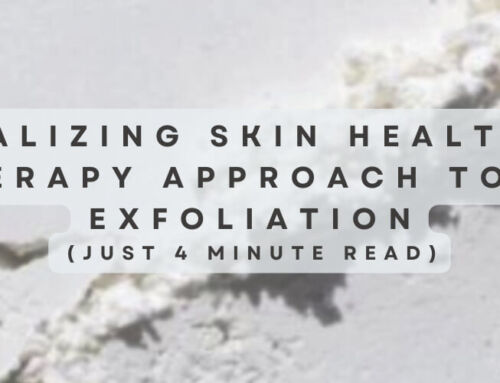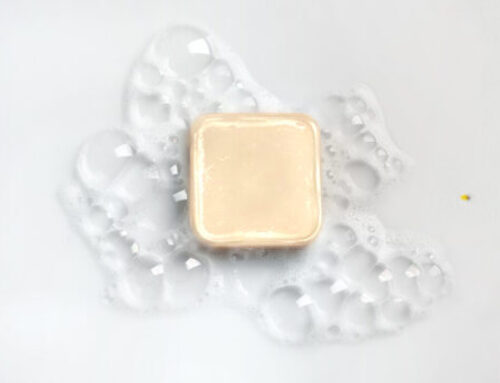Have you ever read the words “pH balanced” on your cosmetics and wondered what it meant? Trying to recall what the coveted balance is may send you back to your high school chem class. Somewhere between the periodic table and mixing strange liquids, you learned the pH scale. Quick refresh: It runs from 0 to 14 and measures how acidic (<7) or alkaline (>7) a substance is.
But what does it have to do with your skin and the acid mantle? What internal and external factors cause it to get out of whack? We’ve got it all covered in today’s class–ahem–article.
Your Skin Flourishes in an Acidic State
Our skin has a thin, protective layer on its surface, referred to as the acid mantle. It’s made up of sebum excreted from the skin’s sebaceous glands, which is shaken (not stirred) with lactic and amino acids from sweat to create the skin’s pH. We discussed in this deep dive into the acid mantle that it should be slightly acidic – clocking in at about 5.0 while our cells and blood have a nearly neutral (~7.4) pH.
A combination of proper pH function and preserving the acid mantle on the surface is what our skin needs to bless us with healthy skin.
In essence, this pH gradient controls specific enzymes in each layer, enzymes which are responsible for the formation of a resilient barrier and which regulate the desquamation (the break down) of corneoctyes–a natural process of renewing the skin.
You May Be Unknowingly Altering Your pH
Now, just like something too acidic can upset your stomach flora (heartburn, anyone? yikes!), the same principle is true with your skin. Your skin needs the correct (i.e., ~5.0) pH for the good flora to live on your skin and keep bad bugs at bay (e.g., staph/bacteria). It also needs controlled desquamation because without that, you’re looking at thin skin and a defective barrier, i.e. red, dry, rough, or flaking skin or even TEWL—water leaving the skin quickly.
And, unfortunately, there are many things, both internal and external, that can interfere with that delicate balance of your skin’s acid mantle.
Your Skin Color: Darker pigmented skin is ever-so slightly more acidic. In fact, the pH of darkly pigmented skin is lower by about a half a unit – from ~5.0-5.5 in lighter skin to ~4.5-5.0 in darker skin which in the context of your pH gradient, that means a lot.
It’s a bit like earthquakes measured on the Richter scale. Moderately more acidic skin can be the difference between a barrier homeostasis and inflammation, just like a slightly greater earthquake can be the difference between a rumble and devastation.
Body Area: We briefly touched on this: the pH gradient is completely different between your body and your complexion. The places with the biggest pH gap? Your armpits and nether regions (~6.1 – 7.4). That’s why these areas are prone to infection and dermatitis and can be a quick sign your pH is off. The gradient can even vary by location on the face, which is why you may deal with a “problematic area.”
Age & Sex: Your pH rises (e.g., becomes more alkaline) at age 60: That’s because as you age, the NMF and amount of oil or sebum naturally produced by your skin decreases which, in turn, influences the acid mantle and its ability to protect the skin. As for sex, men have shown to have more acidic stratum corneum than women, likely due to hormonal influences.
Traditional Skincare: Formulations typically include preservatives with a specific pH range to help stabilize the formula. Although it does its job, it ultimately conflicts with the pH of your skin and disrupts the acid mantle. They do this because many ingredients have pH-values of about 3 or even lower which would cause chemical burns or irritation, so they neutralize it with a base unless an irritating effect is explicitly intended (like in the case of fruit acid peelings).
To top it off, the occlusive ingredients (e.g., lanolin, mineral oil, and silicones) and/or antimicrobials can alter the microflora of your skin, which has a nasty impact on the formation of a healthy pH gradient across the skin. These ingredients also turn off the natural signals your barrier uses to repair itself.
Surfactants and emulsifiers, common traditional ingredients targeting impurities, wash away the protective bilayers of the stratum corneum and Natural Moisturizing Factor (your key to fighting against water loss and maintaining an acidic environment). This elevates the pH levels of the skin, leading to unwanted complexion issues like inflammation and other barrier problems like atopic dermatitis.
dermaviduals DMS base creams mimic the structure and chemistry of the skin barrier.
As we can see, when searching for the culprit to an imbalance pH or impaired acid mantle, traditional skincare is often on the “Most Wanted” list.
dermaviduals’ hero ingredient, Derma Membrane System, in combination with linoleic acid, acidifies the skin by generating free fatty acids from phospholipids. These substances not only aid in the buffering and formation of a healthy acid mantle, but also boost the integrity and unity of the stratum corneum.
Ideally, a licensed dermaviduals skin care specialist can take a look at the troubled skin with a deep understanding of the above external and internal factors to see what could have caused the pH imbalance. The goal? To create a bespoke cleanser 100% unique to each person’s skin for perfectly balanced, thriving skin.
But of course, we have recommendations: Our DMS moisturizing creams which generate free fatty acids from phospholipids and regulate stratum corneum acidification for sturdy skin that glows + our emulsifier-free cleansers that give a refreshing clean without disrupting the barrier.
Are you a New York State licensed skin care professional? We’re here to support your success and bring your clients amazing results through proven, science-backed products and ongoing education. Apply here to become a dermaviduals retailer!






